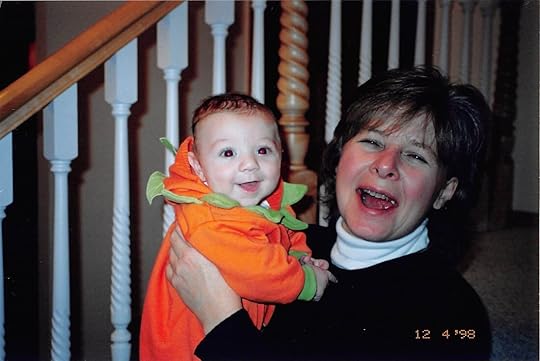Mental Illness and Corrections
 Branden Deal, with Nicolette and Kaycee after the pinning ceremony. Branden is now a CPO, or Chief Petty Officer of the Navy. His specific title is AEC (AW) Branden Deal, which stands for Chief Aviation Electrician (Air Warfare).
Branden Deal, with Nicolette and Kaycee after the pinning ceremony. Branden is now a CPO, or Chief Petty Officer of the Navy. His specific title is AEC (AW) Branden Deal, which stands for Chief Aviation Electrician (Air Warfare).  Kaycee giving Branden his chief pin. In every county in the US that has both a county jail and a county psychiatric facility, the jail has more seriously mentally ill individuals. There are “more than three times more seriously mentally ill persons in jails and prisons than in hospitals.” The nation’s jails and prisons have replaced hospitals as the primary facility for mentally ill individuals. There are more seriously mentally ill individuals in the Los Angeles County Jail, Chicago’s Cook County Jail, or New York’s Riker’s Island Jail than in any psychiatric hospital in the United States. Torrey EF, Kennard AD, Eslinger D et al. More Mentally Ill Persons
Kaycee giving Branden his chief pin. In every county in the US that has both a county jail and a county psychiatric facility, the jail has more seriously mentally ill individuals. There are “more than three times more seriously mentally ill persons in jails and prisons than in hospitals.” The nation’s jails and prisons have replaced hospitals as the primary facility for mentally ill individuals. There are more seriously mentally ill individuals in the Los Angeles County Jail, Chicago’s Cook County Jail, or New York’s Riker’s Island Jail than in any psychiatric hospital in the United States. Torrey EF, Kennard AD, Eslinger D et al. More Mentally Ill PersonsThis is an outline of Frank Weber’s presentation for Minnesota Association of Community Corrections Act Counties on 9/21/2107
Serious mental illness is defined as Schizophrenia, Bipolar disorder and Major Depressive disorder. Serious mental illness costs $193 billion in lost earnings per year.
Impact on Corrections
Mentally ill individuals remain incarcerated for longer than those without mental illness charged for the same offenses. 25% of mentally ill offenders have 3 or more prior sentences. Mentally ill offenders cause considerable management and financial problems for corrections.
Study of jail inmates in New York and Maryland concluded 15% of men and 31% of women had a serious mental illness diagnosed in the last month. Mental illness is associated with substance use, homelessness, poverty and mental instability. The Minnesota Sherriff’s organization estimates 30% of our jail population is struggling with mental illness.
The average stay for mentally ill inmates in jail is longer than for non–mentally ill inmates. In Florida’s Orange County Jail, the average stay for all inmates is 26 days; for mentally ill inmates, it is 51 days. In New York’s Riker’s Island Jail, the average stay for all inmates is 42 days; for mentally ill inmates, it is 215 days. The main reason mentally ill inmates stay longer is that many find it difficult to understand and follow jail and prison rules. In one study, jail inmates were twice as likely (19 percent versus 9 percent) to be charged with facility rule violations. In another study in the Washington State prisons, mentally ill inmates accounted for 41 percent of infractions even though they constituted only 19 percent of the prison population. (http://consensusproject.org/infocente..., last accessed April 3, 2006. Turner C, Ethical issues in criminal justice administration, American Jails, January/February 2007. Butterfield F. Study finds hundreds of thousands of inmates mentally ill, New York Times, October 22, 2003. )
Mentally ill inmates cost more. Mentally ill inmates cost more than non–mentally ill inmates for a variety of reasons, including increased staffing needs. In Broward County, Florida, it costs $80 a day to house a regular inmate but $130 a day for an inmate with mental illness. In Texas prisons “the average prisoner costs the state about $22,000 a year,” but “prisoners with mental illness range from $30,000 to $50,000 a year.” Psychiatric medications are a significant part of the increased costs; in July of 2002 at Ohio’s Clark County Jail, prescription drugs costs for inmates exceeded the costs of feeding inmates. Finally, there is the cost of an increasing number of lawsuits, such as the suit brought in New Jersey in 2006 by the family of a “65-year-old mentally ill stockbroker who was stomped to death in Camden county jail”, not accounted for in these statistics. Miller CM, Fantz A. Special “psych” jails planned, Miami Herald, November 15, 2007. Bender E. Community treatment more humane, reduces criminal-justice costs, Psychiatric News 2003;38:28. Gottschlich AJ, Cetnar G. Drug bills at jail top food costs, Springfield [OH] News Sun, August 20, 2002. Guenther A. Family sues Camco over prisoner’s death, [NJ] Courier Post, June 14, 2006.
Mentally ill inmates are major management problems. Because of their impaired thinking, inmates with serious mental illness present major management problems. For example, in 2005 in Mississippi’s Hinds County Jail, one inmate was described as having “tore up a damn padded cell that’s indestructible, and he ate the cover of the damn padded cell. We took his clothes and gave him a paper suit to wear, and he ate that. When they fed him food in a styrofoam container, he ate that. We had his stomach pumped six times, and he’s been operated on twice.” In Wisconsin a 2010 audit of three state prisons reported that “between 55 percent and 76 percent of inmates in segregation [isolation] are mentally ill.” (Mitchell J. Treatment, not jail, urged for mentally ill in Miss., Jackson [MS] Clarion Ledger, January 25, 2009. Ridgeway J, Casella J. Locking down the mentally ill, The Real Cost of Prisons Weblog, February 24, 2010,http://realcostofprisons.org/blog/arc...
_th.html, last accessed April 28, 2011.)
Mentally ill inmates are more likely to commit suicide. Half of all inmate suicides are committed by inmates who are seriously mentally ill. A 2002 study in Washington State reported that “the prevalence of mental illness among inmates who attempted suicide was 77 percent, compared with 15 percent [among inmates] in the general jail population.” In California in 2002, the Los Angeles Times headlined: “Jail Suicides Reach Record Pace in State,” and added: “Some experts blame the recent surge, on forcing more of the mentally ill behind bars.” (Goss JR, Peterson K, Smith LW et al. Characteristics of suicide attempts in a large urban jail system with an established suicide prevention program, Psychiatric Services 2002;53:574– 579. Johnson J. Jail suicide)
The correctional population tripled between 1982 and 2007. One in six of people in jail have serious mental illness, and within that group, over seven in ten have co-occurring substance use disorder. According to Sue Abderholden, Executive Director of NAMI Minnesota, in Changes in the Mental Health System: “The increasing numbers of people with serious mental illnesses in our criminal justice system has seriously strained the resources and staff. Police and sheriffs often cite their frustrations with having to respond to people with mental illnesses, often for public nuisance crimes but other times for a psychiatric crisis. Judges are overwhelmed with the volume of cases, often repeat offenders whose untreated mental illness results in numerous appearances before the court. Jail staff feel particularly lacking in the training and education needed to keep these individuals safe, including those who may be at risk for suicide. Local budgets are strained by the costs of providing medication. Prisons are also not well equipped to address the needs of these inmates.” From an article by Sue Abderholden, Executive Director of NAMI Minnesota. “Changes in the Mental Health System.” Published on the Council on Crime and Justice website at: http://www.crimeandjustice.org/councilinfo.cfm?pID=55
45% of mental illness goes untreated
40% of schizophrenia is untreated (When treated 25% show good recovery and 75% show improvement) Every new psychotic episode takes twice as long to recover from, and takes more medication to recover from. More medication means more side effects.
51% of severe bipolar disorder is untreated (The success rate for treating bipolar disorder is 80%.)
Depression (When treated 30% recover in 3 months, 50% recover in 6 months and 80% recover in one year.) 2/3rd of suicides are attributed to untreated depression. The vast majority of people who attend counseling and take medication for 9 months for depression will never need medication and counseling again. Untreated depression leads to increased cortisol levels, which can slow the slow the production of new neurons and cause the hippocampus to shrink. This can lead to memory problems.
Mental Illness in Jails in Minnesota
The vast majority of Minnesota’s county jails offer psychiatric medications, as is required by law, but often that is the extent of their mental health treatment services. A report completed by the Department of Human Services in Minnesota in 2015 noted, “Not a single jail in Minnesota coordinates care with community providers on a consistent and widespread basis.” Since 2006, jails perform a health screen upon entry, but there is a strong likelihood for mental health deterioration after time in jail, particularly since it is common for inmates to not have their medications at the time of arrest. Currently there are no routine follow-up mental health screens in jail. Minnesota Department of Human Services January 2015 43 Report: Offenders with Mental Illness
In addition, rarely do law enforcement, judges and others have access to an individual’s mental health information. They may not know the appropriate questions to ask or the signs to look for to help them determine if the causal factor for the individual’s involvement with the criminal justice system is due to their mental health.
Solutions: Increase resources for probation to ensure reasonable caseloads, training, and access to services. Many jails have difficulty in coordinating discharge services within the time frame of a typical jail stay. There is not enough time and a lack of community resources to direct inmates to, following discharge. There needs to be a coordinated hand off from discharge directly to community resources. For example, jails have had difficulty finding out whether a person booked into jail already has a caseworker. This can lead to delays in service. Currently people are being discharged from jail but often have nowhere to go, drastically increasing the chances that a person will end up returning to jail.
According to the State Advisory Council on Mental Health: There is no over-arching entity that directs how services should be delivered or that is evaluating outcomes in the criminal justice system. We know that least 20 percent of youth involved in the juvenile justice system have serious mental illnesses. Once a youth becomes involved in the juvenile justice system and is detained or incarcerated, access to effective and successful mental health treatment is less likely to occur. This corresponds with an increased likelihood of further and deeper involvement in the justice system into adulthood. 24 See: http://archive.leg.state.mn.us/docs/2... 25 State Advisory Council on Mental Health. (2014). 2014 Report to the Governor and Legis
Mental Illness in Minnesota Courts
What happens to people ruled incompetent to stand trial? More than half the time, nothing—no consequences and no services. In 2014, 119 people were found incompetent to face their criminal charges in Hennepin County. Of those:
· 46 were civilly committed;
· 4 had cases that went unresolved;
· 7 had a 'stay of commitment';
· 62 were released without further treatment
·
Uncommittable offenders fall through the cracks of Minnesota’s criminal justice system. Jack Harvey McClellan was mentally ill, but not mentally ill enough. The 62-year-old veteran came to Hennepin County court’s mental health channels the usual way: He was arrested. Over a six-month period last year, McClellan was charged with eight offenses. Most were minor: trespassing at a grocery store and a veteran affairs building, a couple of small thefts. When McClellan came to court in November for the indecent exposure case, Judge Kerry Meyer flagged him as possibly mentally ill, and a psychologist deemed him incompetent to face the charges. The ruling kicked the case over to civil commitment court, where a new judge would decide if McClellan needed mental health treatment from the state. In doing so, Meyer dismissed the seven misdemeanors. The prosecutor didn’t file the paperwork in the allotted 30 days on the indecent exposure charge (urinating in public) — the only gross misdemeanor — so that disappeared, too. On the civil side, Judge Jamie Anderson didn’t believe McClellan posed enough danger to himself or others to qualify for civil commitment, despite her concerns for his safety. Jack had recently been evicted from his apartment, she noted, and with winter already arriving, “housing of some sort is essential.” Still, Anderson cut him loose, hoping he would seek treatment and find a shelter on his own. McClellan wouldn’t be away for long. By February, he had already been charged four more times for trespassing and theft, which brought him full circle: back in Meyer’s courtroom, where he’d stood not three months before. When he came before Meyer this time, he wore medical boots on both feet. He'd suffered severe frostbite from living on the streets. McClellan is what those in the criminal justice system call a “gap patient.” He doesn’t meet the court’s competency standard to face criminal charges, but he also doesn’t meet the standard for civil commitment: court-ordered, involuntary mental health treatment administered by the state. So he falls through the gap. The Uncommittables: How offenders with mental illnesses fall through the cracks of Minnesota's criminal justice system by Andy Mannix 07/20/15
There has been in increase in civil commitment petitions in Minnesota-- In 2005, there were 244 petitions — called Rule 20s — according to Hennepin County court data. By 2015, the number of petitions hit 567 — a 132 % increase in 10 years. The spike has likely been created by so many people losing their jobs and health insurance since the recession of 2008, while at the same time budget cuts reduced or eliminated community resources.
It's not just a big city problem. According to the Beltrami County Sheriff's Department as many as 70% of the people in that jail are struggling with mental illness. "The country jails have turned into a holding pen for people with mental illness," said Sheriff Phil Hodapp. His jail population has grown 600 % since the '80s. Every incoming inmate is now screened to see if they have mental health issues. Many are so-called "frequent flyers" who come through all the time. Those who fall into rule 20 gap can spend four months or more in the jail, before being released without treatment. Under a state law passed two years ago, those who quality for civil commitment must be transferred to a psychiatric facility within 48 hours. Hodapp says most get stuck on a waiting list as the facilities don’t have openings. Inmates with Mental Illness Not Being Treated, by Tom Lyden . POSTED: NOV 11 2015 08:27PM CST VIDEO POSTED: NOV 11 2015 10:18PM CST UPDATED: NOV 12 2015 03:39PM CST
Hennepin County Sheriff Richard Stanek testified in 2016 at a legislative hearing: “As a State we have hit crisis levels for untreated mental illness… We are telling you today, and our Office of the Legislative Auditor is telling you too, that Minnesota’s County Jails have become de facto warehouses for the mentally ill, because there simply are not enough beds, community placement options, stabilization facilities, or arrest alternatives.” Stanek, who is president of the Minnesota Sheriffs’ Association, stressed three points in his testimony:
Those with mental illness stay jailed far longer than inmates who do not suffer from mental illness.Those with mental illness often stay longer than the sentence for their underlying crime.Inmates with mental illness do not get better while they stay in a County Jail, often they get worse. Damming report released on Minnesota’s jail mental health services. By TAD VEZNER | tvezner@pioneerpress.com | Pioneer Press. PUBLISHED: March 3, 2016 at 12:36 pm | UPDATED: March 3, 2016 at 5:36 pm
A publicly funded diversion program was implemented for 384 mentally ill offenders in Bexar County (San Antonio, Texas—7th largest city in U.S.), which connected offenders with therapists and doctors to prescribe medication. Reduced sentences were offered with involvement in the services. Over the 2 years the program was implemented taxpayers saved $2819 per person with a total cost savings of $1.3 million. The impact on taxpayer costs of a jail diversion program for people with serious mental illness by A. Cowell, J Hinde, N. Broner and A. Aldridge. www.elsevier.com/locate/evalprogplan
What works?Corrections working with mental health providers in the community. Support group or individual treatment (when most effective) for the offender.Cognitive Behavioral Therapy which teaches offenders to self-monitor their recovery. Substance Use treatment Supported employment, in which people with mental illnesses are employed in competitive, integrated work settings with follow-along support.Medication to treat mental illnesses.Family therapy and psychoeducation, in which people with mental illnesses and their families learn about mental illnesses, symptom management techniques, and stress reduction. Improving Outcomes for People with Mental Illnesses under Community Corrections Supervision: A GUIDE TO RESEARCH-INFORMED POLICY AND PRACTICE Seth Jacob Prins Laura Draper for the Council of State Governments Justice Center, New York 10005 © 2009 by the Council of State Governments Justice Center Small caseloads (Specialty Probation) Those who were supervised on specialty probation were nearly three times less likely to return to jail within two years after their release than those on regular probation, researchers reported in JAMA Psychiatry. Positive support appears to be key, with specialty probation officers acting as part counselor and part cop, said lead author Jennifer Skeem, professor of social welfare and public policy at the University of California at Berkeley. “It’s about good, caring relationships with a professional. They seem to have that with specialty officers,” she said in a phone interview. Special probation for prisoners with mental illness cuts recidivism. Wednesday, August 16, 2017 1:37 p.m. CDT By Ronnie Cohen
Are we headed that direction? No. Blue Cross/Blue Shield announced this week that they’re cutting back on their coverage of mental health services, and I haven’t heard of corrections agencies offering smaller caseloads. We need to convince people that in the long run our solutions will save money, victims, and incarceration.
At CORE, 97% of the sex offenders who graduate from our program are not convicted of a sexual offense again. Our best success rates (99%), and our shortest treatment length (13 months on average), occur in our Sartell office where (as a result of our close relationship with SCSU’s graduate counseling program) offenders can get as much individual help as they desire. Our treatment length almost doubles elsewhere, where opportunities for individual sessions are limited. Mentally ill offenders need more individual sessions. If treatment takes too much longer than 1 year, you can build up a waiting list, or have too large of groups. This means you have more untreated offenders (who are the highest risk to reoffend) and the result is more victims, more incarceration and more expensive to tax payers.
Conclusion of Study of 3769 offenders with serious mental illness in Pinellas county Florida (Tampa area) for 4 years.: Public policies designed to increase access to mental health treatment in the community for individuals with serious mental illness in the criminal justice system will reduce future criminal justice expenditures. Untreated were most likely to commit additional felonies. Individuals accessing mental health services were least likely to be rearrested. The use of psychotropic medications were associated with a reduction of violent crimes. The inconsistent use of medications was associated with an increase in misdemeanor crimes and nuisance violations. Factors related to criminal justice expenditure trajectories for adults with serious mental illness by J Robst, R. Constatine, R. Andel, T.Boaz and A. Howe from Criminal Behavior and Mental Health. 21:350-362(2011)
Remember all problems are 1st addressed by being recognized. This is the phase we are in.
Travis Hirshi asked, “Why isn’t everyone deviant?” And found 4 Reasons
1. Attachment = a healthy friend or a healthy partner.
2. Commitment = If you plan for your future, you have more to lose by being deviant.
3. Involvement = work, school and school activities
4. Belief = morals, beliefs, spirituality, religion
Actual quotes from assessments:
“The investigator played that spin the bottle mind game on me.” (I never thought spin the bottle was much of a mind game.)
“As a juvenile I was in the state hospital because I attempted suicide. While I was there, a woman flashed her breasts to me. I never attempted suicide again. I realized there’s a lot I still need to see.”
“It’s really hard to find someone who will get under a cow these days.”
“We have a perfect relationship. She has a license but doesn’t drink, I drink a lot, but don’t have a license.”
Thanks for listening,
Frank
 Janet Brixius and her mother, Mae Gross in 1966
Janet Brixius and her mother, Mae Gross in 1966  Mae Gross with granddaughters Pam Sitzman and Brenda Weber in 1966
Mae Gross with granddaughters Pam Sitzman and Brenda Weber in 1966  Marie Steele and her sister Mae (Amelia) Gross at Candy & Rueben's wedding in 1969
Marie Steele and her sister Mae (Amelia) Gross at Candy & Rueben's wedding in 1969  Rod Brixius 1970
Rod Brixius 1970  Nicolette on swing in 1988
Nicolette on swing in 1988  Halloween 1990 Niolette Deal and Shane Weber
Halloween 1990 Niolette Deal and Shane Weber  Nicole Meehl-Bueckers, Angie (Seppelt) Athman, Nicolette (Weber) Deal and Kayla (Boser) Gall
Nicole Meehl-Bueckers, Angie (Seppelt) Athman, Nicolette (Weber) Deal and Kayla (Boser) Gall  Mae and Roman Gross with Nicolette (Weber) Deal at her 1st Communion in 1993 Mae was always wonderfully kind to everyone. Roman was a good man, but opinionated and drove so slow that you could read the tires on his truck when he drove by.
Mae and Roman Gross with Nicolette (Weber) Deal at her 1st Communion in 1993 Mae was always wonderfully kind to everyone. Roman was a good man, but opinionated and drove so slow that you could read the tires on his truck when he drove by.  Nicolette, and Shane holding Preston in 1993
Nicolette, and Shane holding Preston in 1993  Nicolette and Shane in 1996
Nicolette and Shane in 1996  Alex Banick and Pam Sitzman in 1998 The remaining pictures are from Germany in 2006
Alex Banick and Pam Sitzman in 1998 The remaining pictures are from Germany in 2006  Nicolette and Brenda dancing at the Halfbrau House in Munich
Nicolette and Brenda dancing at the Halfbrau House in Munich  Shane
Shane  Preston
Preston  Preston
Preston  Brenda
Brenda  Brenda
Brenda
Published on September 21, 2017 18:41
No comments have been added yet.



